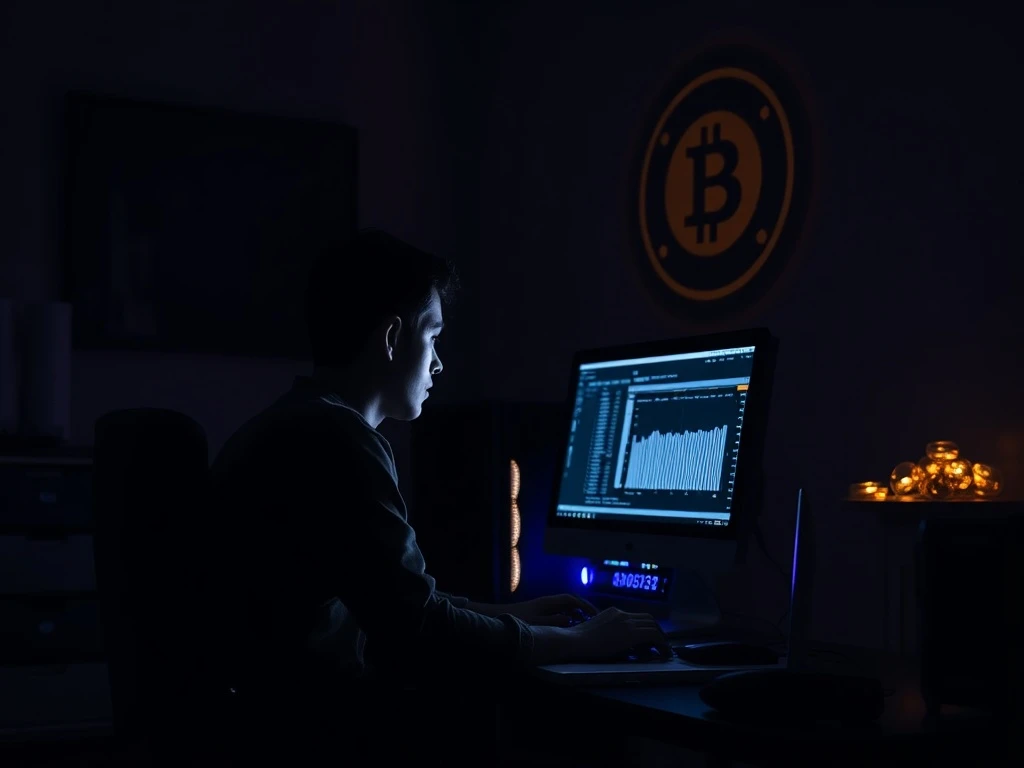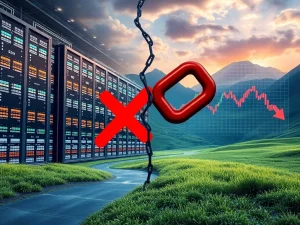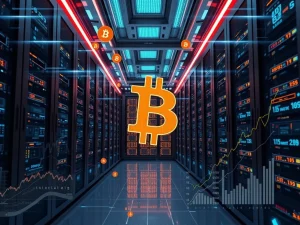Solo Bitcoin Mining: How 5 Miners Achieved Remarkable $350K+ Wins in 2025

For anyone immersed in the world of cryptocurrencies, the idea of striking it rich through individual effort is a powerful draw. However, the reality of modern solo Bitcoin mining often paints a different picture, one dominated by large, industrial-scale operations. Yet, 2025 delivered a series of truly remarkable surprises. Five independent miners, operating outside massive mining pools, each successfully mined a Bitcoin block. Consequently, they earned rewards exceeding $350,000. These extraordinary achievements remind us that Bitcoin’s unpredictable, decentralized nature still offers incredible opportunities, even for small-scale participants.
The Unlikely Feat of Solo Bitcoin Mining
Bitcoin (BTC) mining involves validating transactions and securing the network. Miners solve complex cryptographic puzzles to achieve this. Today, huge mining farms with advanced, specialized hardware typically dominate this process. Therefore, the odds of a solo miner, a lone individual attempting to discover a block, are astronomically low. In 2025, the mining difficulty reached an all-time high. For a solo miner with standard hardware, the probability of success felt comparable to winning a major lottery. The Bitcoin network’s total hash rate consistently increases, further reducing the chances for small-scale miners. For instance, a miner with a 100-terahash per second (TH/s) machine, like a high-end Antminer S19, faces less than a 0.0001% probability of solving a block on any given day. As a result, a solo miner could wait months or even years to earn a single Bitcoin block reward.
Did you know? Bitcoin mining began with Satoshi Nakamoto’s “genesis block” on Jan. 3, 2009. That block awarded 50 BTC as the mining reward. Every miner since has built on that foundational proof-of-work legacy.
Unveiling the 2025 Bitcoin Block Reward Triumphs
Each solo Bitcoin miner successfully solved a block independently. They earned rewards valued at approximately $350,000 or more. This feat remains nearly unprecedented in Bitcoin’s mining history. Here are the specifics of these incredible 2025 2025 Bitcoin wins:
- Block 883,181 (Feb. 10, 2025): An independent miner successfully secured this block. They received a reward of 3.125 BTC, valued at over $300,000 at the time. This anonymous miner processed 3,071 transactions, yielding a total reward of 3.15 BTC.
- Block 903,883 (July 4, 2025): On this date, a solo miner with only 2.3 petahashes per second (PH/s) mined the block. They received 3.173 BTC, valued at approximately $349,028. The likelihood of such success was about one in 2,800 per day, or roughly once every eight years for that specific hash rate.
- Block 907,283 (July 26, 2025): Another independent miner, utilizing the Solo CKPool service, successfully mined this block. The miner collected the block reward of 3.125 BTC, valued at $372,773. Block 907,283 included 4,038 transactions and generated $3,436 in transaction fees.
- Block 910,440 (Aug. 17, 2025): A different solo miner, also using Solo CKPool, achieved success. They collected the standard 3.125 BTC plus about 0.012 BTC in transaction fees. Their total Bitcoin rewards reached approximately $373,000. This block processed 4,913 transactions, totaling $1,455 in fees.
- Block 913,632 (Sept. 8, 2025): An individual Bitcoin miner successfully mined this block. The miner’s reward totaled 3.14 BTC, then valued at $348,111. This sum included the standard 3.125 BTC block reward and an additional 0.019 BTC from transaction fees. The block contained 1,956 transactions.
These victories clearly demonstrate that individual miners can still overcome incredible odds. They achieve significant rewards, even when large-scale operations dominate crypto mining. Collectively, these wins underscore Bitcoin’s unique blend of unpredictability, decentralization, and opportunity.
Did you know? Bitcoin block rewards halve roughly every four years. In 2024, the reward dropped to 3.125 BTC per block. Halvings reduce miner income but often precede price rallies, creating anticipation across the crypto market. These events highlight how mining shapes Bitcoin’s monetary policy and scarcity over time.
Factors Behind These Remarkable 2025 Bitcoin Wins
Individual miners rarely succeed in solving a block. Large mining companies, such as Bit Digital, Riot Blockchain, and Marathon Digital, typically validate most Bitcoin blocks. This is due to their immense computational power. However, in 2025, solo Bitcoin miners earned block rewards thanks to a unique combination of network and market factors. High levels of on-chain activity resulted in miners receiving not only the standard 3.125-BTC block reward but also substantial additional fees. This significantly increased their overall earnings. Furthermore, Bitcoin’s price consistently stayed around or above $100,000 since the start of 2025, making these rewards exceptionally valuable.
These earnings stood out because the solo miners secured their wins with small-scale equipment. Typically, solo miners with just a few rigs face extremely low odds of solving a block. However, upon their success, they gained the same large, fee-enhanced rewards as large-scale mining operations. This transformed their modest setups into one-time gains of over $350,000. Satoshi Nakamoto’s white paper outlined Bitcoin’s foundational concept: a fixed supply of 21 million BTC. Of this total, over 19 million has already been distributed to miners as block rewards.
Did you know? Bitcoin mining consumes significant amounts of electricity, comparable to the annual consumption of some nations. Critics highlight environmental impact. However, miners are increasingly shifting to renewable sources such as hydropower, solar, and geothermal energy.
Understanding Bitcoin Hash Rate and Network Security
Hash rate is a critical factor in Bitcoin mining. It measures the total computing power used to solve the network’s cryptographic puzzles. A higher Bitcoin hash rate strengthens network security. It makes it much harder for malicious actors to tamper with transactions. For miners, the hash rate directly determines their probability of successfully mining a block. Large mining pools combine their hash rates to improve their chances of consistent rewards. Conversely, solo miners with lower hash rates face much smaller odds.
The Bitcoin network adjusts its mining difficulty every 2,016 blocks. This maintains an average block time of about 10 minutes, regardless of the total computing power. This adjustment ensures fairness and stability but also intensifies competition as the global hash rate rises. Overall, the hash rate indicates both the security of the Bitcoin network and the economic feasibility of mining. According to CoinWarz, on Jan. 1, 2025, the hash rate on the Bitcoin network was 702.8319 exahashes per second (EH/s). This figure increased to 1,285.6948 EH/s by Sept. 20, 2025. This consistent increase highlights how mining difficulty on the Bitcoin network steadily grows.
Tools and Platforms Empowering Solo Miners
Platforms like Solo CKPool provide the essential technical framework for independent miners. They connect directly to the Bitcoin network. Unlike large mining pools that distribute rewards among numerous participants, these platforms allow a solo miner to receive the entire payout upon successfully solving a block. This approach supports decentralization. It also offers stable connections and reliable software support. However, the journey remains challenging. Solo miners face significant expenses, including high energy costs and the purchase and maintenance of ASIC hardware. They must compete against a global network with immense computational power. The chances of success are very slim, demanding considerable patience, as many miners may never solve a block. Nevertheless, the potential for substantial rewards, especially during times of high transaction fees, makes the effort worthwhile for some. These platforms genuinely create opportunities for independent miners, enabling remarkable victories against formidable odds.
The Enduring Vision of Decentralized Bitcoin Mining
Solo successes in Bitcoin mining serve as a powerful reminder of the network’s open and permissionless structure. Satoshi Nakamoto, Bitcoin’s creator, envisioned a decentralized network. In this network, anyone with computational power could mine and compete for block rewards. These recent wins suggest that successful Bitcoin mining is not solely the monopoly of large mining pools. Even small, independent miners can achieve significant success. Their triumphs underscore Bitcoin’s core principles: a level playing field where determination and a touch of luck can lead to extraordinary outcomes, inspiring a new generation of enthusiasts to explore solo Bitcoin mining possibilities.










